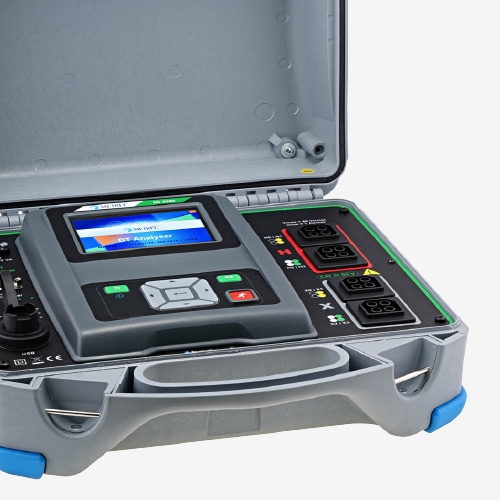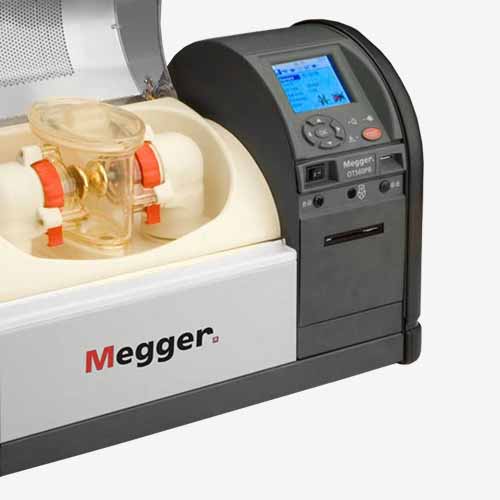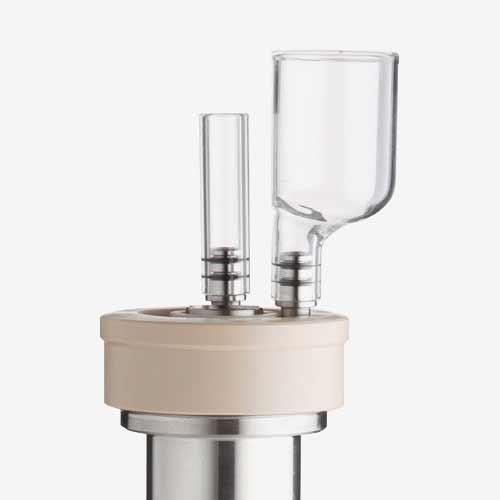Transformer Testing
About Transformer Testing
Transformers, motors, and generators are all essential equipment that are often integral to the operation of a system. When these devices are not running at full efficiency, or are damaged by excessive vibration, contaminants, and various other factors, this can lead to an overall loss of efficiency and potentially financial loss.
The testing devices included within this category are designed to give users all the tools they need to ensure that motors, generators, and transformers can be kept running at optimal levels of efficiency. Any problems can be rectified long before they become more significant problems. Regular testing procedures are highly recommended on these devices to make sure that any sudden issues are addressed (after all, problems can occur at any time).
Phase rotation testers are commonly associated with the testing of motors as they evaluate exactly how three-phase systems are rotating with each other. When incorrect phase rotation is taking place this could cause the system to run incorrectly and would be flagged up when testing using a phase rotation tester.
Tachometers are used for measuring RPM (revolutions per minute) on machinery with rotating parts. When a device rotates at a level not specified due to an error, this could lead to a build-up of friction levels, weakening of parts, and eventually could cause the system to break entirely. A tachometer evaluates that the correct level of RPM based on the system's correct working parameters is present and can be used to spot excessive RPM levels. These testers can either be non-contact and use laser beams for measurement purposes or can be full-contact devices that constantly log RPM over time.
High-power electrical transformers rely on the insulative properties of oil to correctly operate. The problem with using oil in this way is that the oil is constantly subjected to electrical current, leading to a gradual breakdown of the oil's overall efficiency. Excessive electrical output also causes the oil to react with metallic components and other contaminants that might be in the air/from other applications, leading to oil being filled with components that simply shouldn't be there causing the oil to work incorrectly.
Transformer oil testers are designed to test insulative oils (including mineral, silicone, and ester oils) to evaluate the dielectric strength (IE the voltage resistance) of the oil. To perform this test a sample of the oil is taken, placed inside a vessel, and inserted into a transformer oil tester. The sample will then be safely subjected to high levels of voltage until oil breakdown occurs; by taking this reading, the user is then able to determine how much electrical power oil can withstand and change the oil over if the dielectric strength is too low.
Turns ratio testers work with transformers to ensure that the turning of the transformer produces the optimal levels of power and is working within the correct thresholds. Regular testing with these devices should be performed to ensure correct transformer operation.
Vibration testers vary from handheld units to complex instruments that can measure multiple vibration channels simultaneously. One of the biggest downsides of industrial-grade machinery (and perhaps lesser devices) is that they often vibrate due to their operation levels. This vibration can then in turn lead to the loosening of components, cause internal damage to the system, and can gradually build up further as the age of the system increases. Unchecked vibration is also highly dangerous to those working around the system.
A vibration meter is used to accurately determine the level of vibration on the system and can be used to log levels over time or measure single values.
Popular Products
-
Megger TAU3 Three Phase Switched Multifunction Turns Ratiometer, Winding Resistance Ohmmeter: An advanced device for transformer testing. It combines a turns ratio tester and winding resistance ohmmeter, allowing for efficient and accurate analysis of windings. Quick, reliable measurements, providing vital data to maintain and optimise transformer operations. Basic, Professional or Expert models are available
-
Claude Lyons Portavolt Variable Transformer (10 Amp): A sought-after model known for its robust construction and reliable performance. It provides precise voltage control, ideal for laboratory experiments, manufacturing, testing, and education. Its versatility and durability ensure consistent voltage adjustments, essential for sensitive equipment. The 10 Amp model balances capacity and manageability, making it a popular choice for professionals needing efficient voltage regulation.
-
Metrel MI3280 Digital Transformer Analyser: An advanced tool designed for comprehensive transformer diagnostics, featuring a wide range of testing capabilities, including insulation resistance, winding resistance, and turns ratio measurements. With a large display, intuitive interface, and robust data storage, it ensures precision and reliability.
-
Megger KF875 Portable Karl-Fischer Oil Test Set: A portable device for measuring moisture in insulating oils using Karl Fischer titration. It requires just one button press and a 1 ml sample, displaying results in micrograms of water and ppm. It’s compliant with industry standards and features an integral printer for on-site use.
-
Megger OTS80PB 80kV Portable Oil Test Set: An 80kV portable oil test set for testing the dielectric strength of insulating oils. It performs automatic breakdown voltage tests on various liquids with high accuracy and repeatability. It features a precision oil vessel, and safety circuitry, and supports custom test sequences and USB updates.
-
Megger 6121-586 Karl Fischer "In Car" Adapter: Charges oil test sets like the KF875, KF-UNI, and KF-LAB MkII via a vehicle’s cigarette lighter. It’s ideal for maintaining equipment readiness during travel and reducing downtime for fieldwork.
-
Megger 1007-153 ASTM Alternative Propeller Shaft Assy: Designed for use with OTS AF and PB oil test sets. It includes three ASTM-compatible propellers for precise dielectric strength testing in various environments. Durable and reliable, it's ideal for both lab and field applications.
FAQs
-
What is transformer testing?
Transformer testing verifies specifications, performance, and reliability before and after installation, ensuring safe and efficient operation. It includes type tests for design validation, routine tests for operational performance, and special tests based on customer needs. Pre-commissioning tests assess condition on-site before service, comparing results with factory test reports. -
Why is transformer testing important?
Transformer testing is vital for ensuring reliability and efficiency in power systems. It evaluates electrical performance and insulation strength, preventing failures and extending lifespan by identifying minor issues. Additionally, it enhances safety by reducing on-site incidents and equipment damage, enabling utilities to maintain transformer health for consistent power delivery. -
What are the different types of transformer tests?
Transformer testing ensures the reliability, efficiency, and safety of transformers and is categorized into type tests, routine tests, and special tests. Type tests validate a design, including winding resistance and insulation resistance. Routine tests, performed on every unit, cover magnetizing current and dielectric tests. Special tests are tailored to specific needs, such as short-circuit and temperature rise tests. Together, these methods maintain transformer health and ensure safe, efficient operation. -
How do you perform a transformer ratio test?
First, isolate the transformer from the power source and secure connections. Connect the Transformer Turns Ratio (TTR) tester to the high voltage (HV) and low voltage (LV) windings. Apply low voltage to the HV winding and measure the induced voltage in the LV winding. The TTR tester calculates the ratio by dividing the HV voltage by the LV voltage, repeating this for all tap positions. Ratios should be within 0.5% of the nameplate values to confirm proper operation, helping identify issues like shorted turns or incorrect connections. -
How is insulation resistance testing conducted on transformers?
Insulation resistance testing, or the Megger test, evaluates a transformer's insulation by applying a high DC voltage and measuring leakage current. The transformer is first disconnected from power and grounded. Test leads are connected to the windings and ground, with a voltage of 500V to 5kV applied for one minute. Results are recorded and compared to standard values to assess insulation condition, helping detect deterioration early for improved reliability and safety. -
What is power factor testing in transformers?
Power factor testing in transformers evaluates insulation conditions by measuring dielectric power loss with applied AC voltage. The power factor, the ratio of power dissipated to input volt-ampere, is expressed as a percentage. A low power factor indicates good insulation, while a high power factor suggests deterioration from moisture, contamination, or ageing. This test helps identify issues early, enhancing reliability and extending service life. -
How is a transformer winding resistance test conducted?
To conduct a transformer winding resistance test, first disconnect the transformer from power and ground it for safety. Connect test leads from a winding resistance tester to the windings, inject a known DC, and measure the voltage drop. Calculate resistance using Ohm’s Law (R = V/I), repeating for each winding and phase. Compare results to standard values to identify issues like shorted turns or loose connections, ensuring early detection of potential problems for reliability and efficiency. -
What are the common signs of transformer failure?
Common signs of transformer failure include overheating, which may cause a burning smell; unusual noises like buzzing or grinding; oil leaks that risk equipment damage; and reduced power or efficiency in the connected circuit. Monitoring these indicators is crucial for early detection and preventing catastrophic failures. -
Why is oil testing important for transformers?
Oil testing is vital for transformers, ensuring reliability and longevity. Transformer oil acts as an insulator and coolant, but it can degrade over time due to contaminants and moisture. Regular testing detects issues early, allowing for timely maintenance like filtering or replacing the oil, which helps prevent failures and extends the transformer’s service life. -
What is the purpose of a dielectric test on a transformer?
The dielectric test on a transformer verifies the insulation's ability to withstand electrical stress, ensuring it can handle operational and transient overvoltages. By applying high voltage and measuring the response, the test identifies insulation weaknesses, ensuring reliability and safety while preventing failures and maintaining efficient power delivery. -
What are the steps involved in pre-commissioning tests for transformers?
Pre-commissioning tests for transformers ensure reliability and safety before operation. These include visual inspections, insulation resistance tests, and winding resistance measurements. The turns ratio test verifies winding ratios, while vector group and polarity checks confirm phase relationships. Additional tests assess insulation condition and core performance. For oil-immersed transformers, Dissolved Gas Analysis is performed. Operational checks ensure cooling systems function properly, and functional tests simulate normal conditions, confirming overall performance and readiness for safe use. -
What is the purpose of transformer turns ratio testing?
Transformer turns ratio testing verifies the primary to secondary winding ratio, ensuring efficient and safe operation. It detects issues like shorted turns or incorrect connections that can lead to failure. By confirming the ratio, engineers ensure compliance with design specifications and reliable performance under load. This testing is crucial for new transformers during commissioning and for existing ones during maintenance to identify potential problems early. -
How do you perform a transformer sweep frequency response analysis?
To conduct Sweep Frequency Response Analysis (SFRA) on a transformer, a sinusoidal signal is injected into the windings across a wide frequency range. The resulting signal is measured at another terminal, producing electrical transfer functions plotted as magnitude and phase angle against frequency. These results are compared to reference data to detect mechanical issues like winding deformation or core movement. SFRA is essential for diagnosing transformers during commissioning, after significant events, or as part of regular maintenance to ensure mechanical integrity. -
What is the significance of transformer temperature rise testing?
Transformer temperature rise testing evaluates a transformer's ability to manage heat during operation. Excessive temperature can cause insulation degradation and failure. By measuring temperature increases in windings and insulating oil, engineers ensure safe thermal limits, maintaining longevity and reliability. This testing is essential during manufacturing and routine maintenance, providing insights into thermal behaviour and overall health. -
How often should transformers be tested?
Transformers require regular testing to ensure reliability and longevity. Routine tests include annual inspections, insulation resistance, oil analysis, and thermographic surveys. Comprehensive tests like Sweep Frequency Response Analysis (SFRA) and Dissolved Gas Analysis (DGA) are performed every three to five years or after significant events. Pre-commissioning tests are essential for new transformers. Regular testing identifies potential issues early, enabling timely maintenance and preventing unexpected failures, ensuring safe and efficient operation throughout the transformer’s lifespan. -
What equipment is used for transformer testing?
Transformer testing is vital for power system reliability and efficiency, using specialised equipment. Key devices include insulation resistance testers (Meggers) for winding insulation, turns ratio testers for verifying winding ratios, and winding resistance meters to detect short or open circuits. Dielectric strength testers assess insulation durability, while high-voltage testing equipment ensures the transformer can handle operational stresses. -
What are the common failure modes in transformers?
Transformers, while reliable, can face common failures. Insulation failure often results from thermal stress, ageing, or moisture, leading to short or open circuits. Overloading causes overheating and insulation degradation. Short circuit faults arise from insulation breakdown, resulting in excessive current flow. Bushing failures due to ageing or stress can cause electrical breakdowns, while core faults from overheating compromise efficiency. Regular maintenance and monitoring are crucial to mitigate these issues and ensure longevity. -
How do you interpret transformer test results?
Interpreting transformer test results involves analyzing key parameters to assess condition and performance. High insulation resistance indicates good insulation health, while transformer turns ratio (TTR) results should match design specifications; deviations suggest winding issues. Winding resistance measurements identify short or open circuits and dielectric strength tests reveal insulation durability, with lower values indicating degradation. Load loss and impedance voltage measurements assess efficiency. Consistent results across phases are crucial, as discrepancies may indicate internal faults. Regular analysis and comparison with baseline data are vital for effective maintenance and reliability. -
What is the difference between routine and type testing for transformers?
Routine and type testing are crucial in transformer manufacturing and maintenance. Routine tests on every unit ensure compliance with operational standards through measurements like winding resistance and voltage ratio. In contrast, type tests are comprehensive evaluations of prototypes to validate design, including temperature rise and dielectric tests. Routine tests assess individual quality, while type tests confirm the overall design and specifications of the transformer model. -
Can transformer testing be done while the unit is energized?
Testing a transformer while energized is generally unsafe and may produce inaccurate results, as most tests, like insulation and winding resistance, require de-energization for safety and accuracy. However, some condition monitoring tests, such as infrared thermography and partial discharge testing, can be performed in service to identify issues without interrupting power. Overall, while some diagnostics can occur on energized transformers, comprehensive testing typically requires de-energization. -
What are the safety precautions for transformer testing?
When testing a transformer, follow strict safety precautions to protect personnel and equipment. Ensure the transformer is disconnected from power and verify no residual voltage with a tester. Wear appropriate safety gear, discharge residual energy with a grounding rod, and conduct tests in a dry, stable environment. Isolate the transformer from other equipment for accurate measurements, and have the manual and nameplate data available, identifying all test points in advance. These precautions ensure a safe and effective testing process.


 Transformer Analysers & Ratiometers
Transformer Analysers & Ratiometers
 Transformer Oil Testers
Transformer Oil Testers
 Oil Tester Accessories
Oil Tester Accessories
